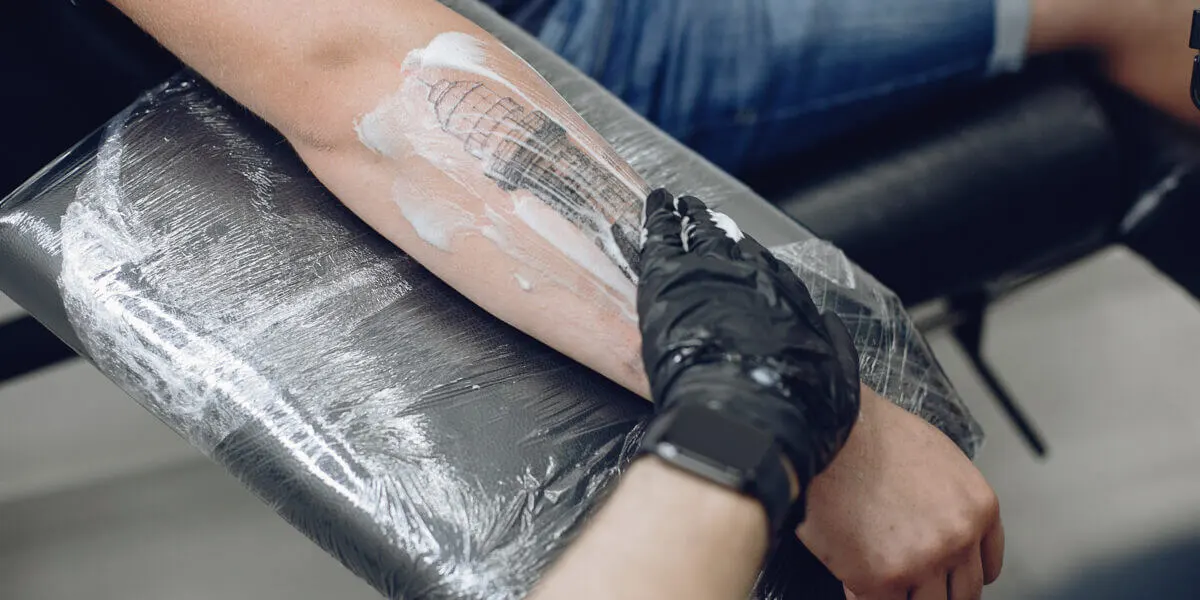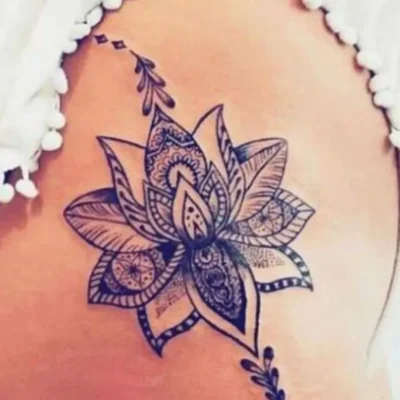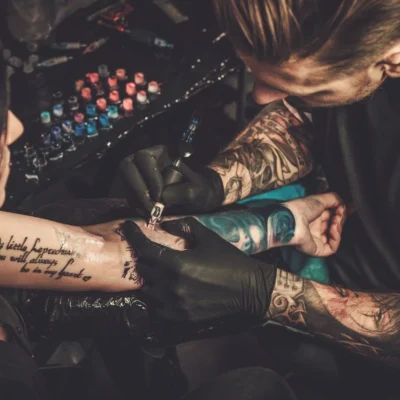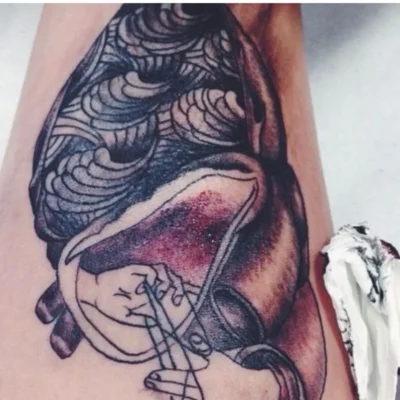Getting inked can be an exciting endeavor, but it also has its pitfalls and downsides. If you are gearing up for your first tattoo or considering adding another one to your collection, the first question that will cross your mind is – “Will it hurt?” Spoiler alert: It does! – A lot! Well, this is where numbing creams come in handy.
These numbing solutions are designed to remove the pain, making the tattooing process more bearable. For this purpose, a wide variety of formulations in the form of sprays, ointments, and creams are available in the market for you to choose from. However, the real question is – does numbing cream work for tattoos? And do they live up to the hype? Let’s explore the reality of these numbing creams and how to make tattoos less painful with numbing creams in this blog post together.
What is Tattoo Numbing Cream?
A tattoo numbing cream is a specially derived tattoo ointment to numb and reduce pain. These creams are topical anesthetic agents that artists use to make the tattoo-making process easier and more bearable for their clients.
Pain, discomfort, and soreness are the primary features of the tattoo-making process. These characteristics can make the entire experience too much to handle for some people. Tattoo-numbing cream acts as a game-changer in this case. Although these creams won’t numb you, they can take the edge off, making the experience more bearable.
What are the Types of Tattoo Numbing Creams?
There are many different types of tattoo numbing creams available in the market. This variation arises based on their mechanism of action, routes of administration, skin types, and suitability.
Depending on these variations, some common types of tattoo numbing creams available in the market are:
- Sprays
- Numbing patches
- Pre-treated tattoo bandages
- Compound creams
- Over-the-counter ointments
- Topical anesthetic creams
- Topical anesthetic gels
How Does Tattoo Numbing Cream Work?
The main function of tattoo numbing creams is to reduce the pain, stinging, and irritation of the injections and inks. They work primarily on the pain receptors and pain pathways in the skin.
However, the mechanism of action of pain numbing varies from cream to cream. Some creams work by cutting off the pain at the nerve endings. Others create a long-term numbing effect. The common methods of action used by tattoo numbing creams include:
1. Nerve Deadening
Nerve-deadening is a short-term numbing effect of tattoo creams that protect the skin from the initial shocks of the tattoo needles and pricks. They do so by desensitizing the superficial nerve endings, preventing them from registering pain signals from the trauma to the skin.
Most of the creams and gels have a topical application that penetrates the skin only till the first five layers of the epidermis. Therefore, the dermis and the deeper layers cannot catch the numbing effect. It means that the person will still feel a little pain when the needle penetrates the deeper layers of the skin.
The half-life of the nerve deadeners lasts for about one to two hours. The effect of the creams may wear off after this time. If your tattooing session will last long, you might need another application soon enough.
2. Nerve Blocking
Numbing creams do work for tattoos through nerve blocking. They work by interrupting pain signals sent to your brain. When you apply these nerve-blocking creams to the skin before a tattoo, they numb the area for a while, making the tattoo drawing less pain-sensitive.
In simpler words, these blockers “turn down the volume” on your pain receptors, allowing you to endure the tattooing process with significantly reduced discomfort. While they don’t completely remove the pain, they make it more controllable, helping you get through your tattoo session more comfortably.
3. Vasoconstriction
Last but not least, vasoconstrictors are an active component of tattoo-numbing creams. They may not act directly on the nerves but have a strong para-numbing role in pain reduction.
Vasoconstrictors ideally act on the blood vessels to constrict them, reducing the blood supply to the targeted area. This constriction helps in slowing the absorption of the nerve deadeners and nerve blocker components of the creams, prolonging their action in the tissues. It means your cream will last longer than simple nerve blocker agent creams.
What are the Tattoo Numbing Cream Ingredients?
Tattoo-numbing creams come in various formulations, specifications, and doses. But in general, they all contain alternating combinations of active ingredients that perform the task of nerve numbing, nerve blocking, and vasoconstricting.
The main active components used in tattoo numbing creams are:
- Lignocaine – Nerve Blocker
- Lidocaine – Nerve Deadener
- Tetracaine – Nerve Blocker
- Benzocaine – Nerve Blocker
- Epinephrine – Vasoconstrictor
All these components work with a different mechanism of action. However, using tattoo numbing products with all active ingredients is ideal for a long-lasting effect.
Note: Epinephrine has the potential to increase heart rate. Therefore, always use this in the smallest quantity possible. Do not use it if you have a heart condition and always consult a doctor beforehand.
How to Use Tattoo Numbing Cream?
If you are wondering how well numbing cream works for tattoos, then it is a no-brainer that application is the key to gaining the correct results.
The application process for these numbing creams is quite simple and straightforward. You can follow the steps below to get the proper results of tattoo numbing cream.
- First, clean the skin thoroughly with water to remove the dead cells.
- Dry the skin with a paper towel or a soft and clean cloth.
- Perform a patch test before using it. You can do so by applying a minute quantity of the cream on the tattoo area and leaving it for 5-10 minutes. Check for any allergies or skin reactions.
- If there is a reaction, discontinue the use, wash your skin, and consult a doctor.
- If no reaction occurs, apply a generous layer of the numbing cream to the area, and allow it to sit for the recommended time (usually 30 minutes to an hour)
- Apply a cling wrap to allow the cream to get absorbed in the deeper layers of the skin properly.
- After 30 minutes, wash the areas and prep the skin with a stencil for the tattoo.
Make sure to follow the cream’s specifications and guidelines for the best results. If your appointment gets prolonged, add additional numbing sprays every 20 minutes or use an additional local anesthetic agent to numb the pain.
What are the Pros and Cons of Using Tattoo Numbing Cream?
Tattoo-numbing creams have undoubtedly made tattoo-making easier, better, and refined in many ways. However, like all things, these creams have pros and cons. These factors keep the debate alive about whether these creams should be used or not.
For a better understanding, here are all the pros and cons of tattoo-numbing creams listed for you.
- They reduce the pain of the tattoo needles and stencils
- They increase the healing time of the tattoo
- The creams make the tattoo-making process fast and less painful
- Larger and more detailed tattoos can be made using these numbing creams
- They may cause potential skin irritations and allergic reactions
- They need a careful application to avoid uneven numbing
- They don’t provide with complete numbing
- Need multiple applications for longer processes
Who Should Use the Numbing Cream?
The decision to use tattoo numbing creams is a personal choice. Some people enjoy the tattoo-making process, taking pain as part and parcel of the process. In comparison, others prefer a more comfortable experience during inking.
However, in general, numbing creams are a popular option among the following people:
- Individuals with lower pain thresholds
- Those who want larger and more detailed tattoos
- First-timers
- People with anxiety
- People with chronic pain issues
Final Thoughts
In recent years, the process of tattoo making has been refined and polished to a great extent. With numbing creams and ointments, the pain of tattoo-making can be controlled in various ways. However, one concern – Does Numbing Cream Work For Tattoos? – still holds back many people. Well, the answer is yes when used correctly!
Numbing creams can be a valuable tool in reducing the discomfort of getting inked. The trick is to always use them wisely and follow the instructions properly. Consult with your tattoo artist before using them. While numbing creams can be a helpful ally in your tattoo journey, it’s essential to remember that they won’t eliminate all the pain but can make the process more bearable for many.
Does Numbing Creams Work For Tattoos FAQs
Can you use numbing cream before a tattoo?
Yes, you can use numbing cream before getting a tattoo. Apply numbing creams to the skin before tattooing to reduce pain and discomfort, making the tattoo experience more tolerable.
How long does numbing cream last?
The half-life of a numbing cream varies depending on type, composition, formulation, and usage. However, a numbing cream’s average effectiveness can last approximately 1 to 2 hours.
Does numbing cream affect tattoos?
Numbing cream itself does not typically affect the appearance or quality of tattoos. It temporarily numbs the skin’s surface but does not impact the ink’s application or final result.
Is numbing cream bad for tattoos?
No, numbing creams are not bad for tattoos. In small amounts, it can help decrease the pain of getting a tattoo. However, excessive or improper use could affect the tattooing experience and outcome, so it’s essential to follow guidelines and consult a professional.
Can you put numbing cream on a fresh tattoo?
No, applying numbing cream on a fresh tattoo is not advised because it may interfere with the healing process and cause complications.







